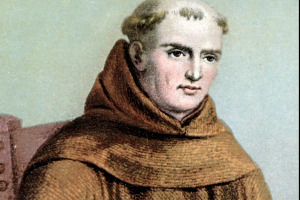Sponsored by the Catholic Textbook Project—Junípero Serra was born on the island of Mallorca off the Mediterranean coast of Spain on November 24, 1713. At the age of 16, he decided to become a priest, and a year later he entered the Franciscan order. For the first 19 years of his life as a Franciscan, Fray Junípero lived in Mallorca, perhaps never sailing even to Spain.
For many of these years he was a lecturer in philosophy in the tradition of the Franciscan philosopher and theologian, Duns Scotus—and was once investigated by the Inquisition. In those years he lectured on the works of his fellow Mallorcan and Franciscan, Ramón Lull, who argued for the peaceful conversion of the Moslems—an idea most Europeans of his day did not think practicable.
In 1749, at the age of 36, Fray Junípero volunteered for the missions in Mexico. What moved him to this?
Why did he volunteer for the missions?
“I have had no other motive,” he wrote years later, “but to revive in my soul those intense longings which I have had since my novitiate when I read the lives of the saints. These longings had become deadened because of the preoccupation I had with studies.”
Arriving in Mexico, nothing was easy
Accompanied by his friend, Fray Francisco Palóu (who later wrote a biography of Serra), Fray Junípero sailed for America on August 30, 1749, arriving at Veracruz in December.
Though offered horses (provided at the expense of the king of Spain) for the 270-mile journey from Veracruz to Mexico City, Serra and another friar who accompanied him refused. Instead, faithful to the ideals of the Rule of St. Francis, the two friars journeyed on foot to Mexico City. In the high mountains that over 200 years earlier Cortés had crossed, Fray Junípero injured his leg.
“With fatigue,” wrote Palóu, “the feet of the Venerable Father Junípero began to swell, so that when he arrived at an hacienda he could not stand. This swelling was attributed to mosquito bites because of the great itching he felt. Having rested there a day, unconsciously he rubbed the one leg too much while he was sleeping. In the morning it appeared all bloody so that a wound resulted which . . . lasted during all his life.”
The Sierra Gorda missions in Mexico
After arriving at the missionary College of San Fernando in Mexico City, Fray Junípero was sent to the missions among the pagan Pame Indians of the Sierra Gorda, a mountainous region 175 miles north of Mexico City. For eight years, he worked among the Pame and learned their language, in which he composed a catechism.
The Sierra Gorda missions were set up as large farms.
The Indians were not forced onto the missions, but invited; once they came and were baptized, however, they were under the authority of the missionaries and were forbidden to leave. The missionaries taught the natives not only the Catholic faith but various crafts, as well as the arts of farming and cattle raising. The missionaries treated the Indians as children, with the aim of educating and training them so that the mission pueblo and farms could eventually be turned over to them, and the missionaries replaced with secular priests.
Mission Indians lived a highly regimented life.
Bells, rung three times a day, summoned the Indians from the fields and workshops to receive their allotments of food. The missionaries provided a special living quarters for girls older than 11 years and unmarried women. The religious life of the missions was very colorful, with processions, images, plain chant, polyphony, and Pame hymns. So beautiful and reverent was the mission liturgy that many Spaniards were drawn to the missions to celebrate holy days.
The College of San Fernando
In 1758, Fray Junípero was recalled to the College of San Fernando. He spent the next nine years as choir master (he had a beautiful voice for song), novice master, and home missionary. A home missionary was a priest who traveled from parish to parish preaching missions to inspire Catholics to a deeper understanding of their faith and dedication to Christ.
Fray Junípero was a zealous preacher, often going to what today we might judge extreme lengths to move his hearers to repentance. From the pulpit, he pounded his chest, scourged himself, and even once applied a lighted candle to his breast. Far from repelling his hearers, Fray Junípero’s style drew many to his missions. His sermons, though long, were in great demand. Certainly the colorful and theatrical appealed to his audiences.
Jesuits expelled from Spanish domains; Franciscans assigned to those Baja California missions
The year 1767 marked a new epoch in Serra’s life. With the Jesuits expelled from the Spanish domains, their missions in Baja California fell to the Franciscans. At the College of San Fernando, Fray Junípero learned that he would be made padre presidente, or head, of the Baja California missions.
The California missions
He remained in Baja California, however, for only about a year before Count Gálvez chose him to found a new missionary enterprise in Alta California.
Longing to go amongst pagans who had never heard the Gospel, Fray Junípero eagerly took up his new task. At the age of 55, Fray Junípero set out on the mission for which his entire life had prepared him.
Music for Mass in the California Missions
Ignacio de Jerusalem y Stella (1707–1769) was an Italian baroque composer who expatriated to Spain and then Mexico, where he became director of the Coliseo, a theater in Mexico City.
In 1750, he became the chapel master at the cathedral of Mexico City, about the time Fray Junípero Serra arrived in Mexico.
De Jerusalem’s music would later be performed in the California missions Fray Junípero would found, by native musicians trained by the Franciscan missionaries. The music of the Mass we present here (the Mass for Eight Voices in D Major, performed by the group, Chanticleer) was long thought lost until a manuscript of it was discovered in the archives of Mission San Fernando in California.




You must be logged in to post a comment.